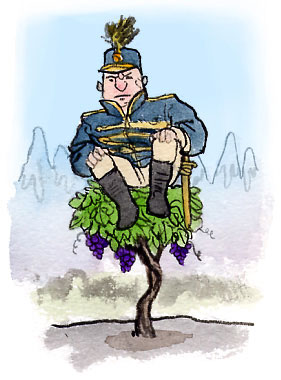
 Schioppettino
Schioppettino
An emperor without a territory. Your hard edged and strong character failed to secure the seat of power for the red party in your Northern Italian home. The upstart political white wing, led by the vivacious Ms. Sauvignon and the congenial Tocai, with a transparent platform and a fresh attitude has won over the electorate of Friuli. Even within your own party, your support has dwindled in favor of the outwardly charming Mr. Refosco. A move to Sonoma has afforded you a new start, albeit, your territory here may be as limited as it was at home.
Appellations Growing Schioppettino Grapes
Appellations producing the most Schioppettino wines:
Schioppettino Grape Details

This ancient red grape variety is indigenous to the Collio Orientali district of Friuli on Italy’s Northeastern boarder with Slovenia. Despite an agreeable wine made from its grapes, the Schioppettino vine has become very obscure, even in its homeland where 20th century pressures to plant more marketable varieties have prompted growers to replace it with the likes of Merlot and Tocai. The decline of the variety is unfortunate as the thick skinned, hard berried grape is arguably the regions highest quality local red variety, yielding deeply pigmented wines with a Syrah-like concentration of darkberry fruit, violets and spice, with a good tannic structure. The wine gains added complexity with age, adding moss and earthy undertones to an already complex profile. Notwithstanding the quality of the wine, in a region best known for fresh aromatic whites, another local red, Refosco, has faired better in establishing a reputation for the regions top red wine. Fortunately, Schioppettino has been rescued from eminent extinction by EU intervention and a small but vibrant cult following in Friuli.
In North America, a small amount of this variety (less than half an acre) was planted by wine maker John Holdredge in Sonoma County’s Russian River Valley, and in 1994 Holdredge made 12 cases of the wine (a half barrel). It is not
widely planted anywhere, but Holdredge believes
it can make a fairly fascinating wine on its own,
or can be a potentially beneficial addition to
Syrah in some vintages. In a wine culture slowly warming up to the unusual and obscure, this may be a variety to watch.
Thanks to Dan Berger for his contribution
